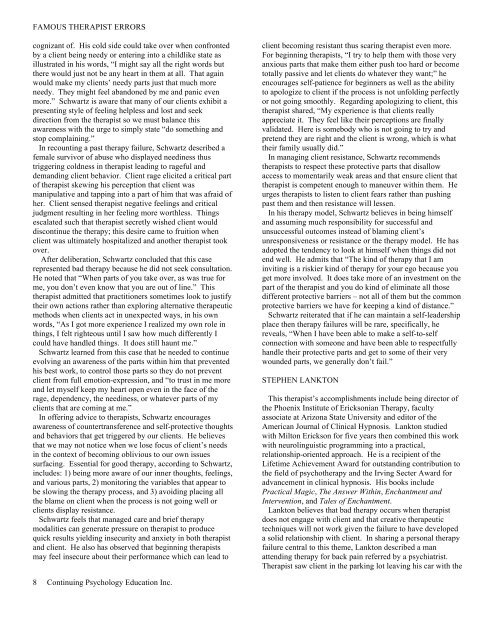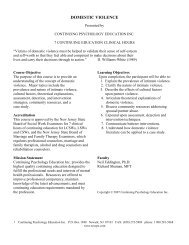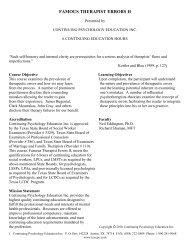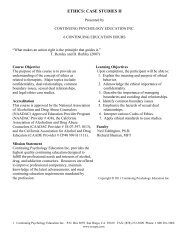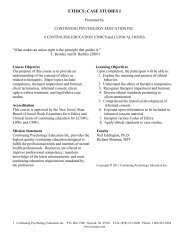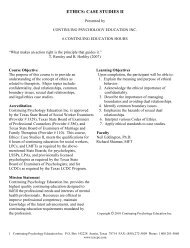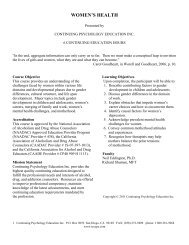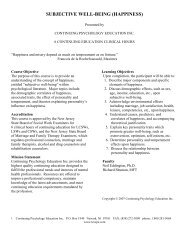FAMOUS THERAPIST ERRORS - Continuing Psychology Education
FAMOUS THERAPIST ERRORS - Continuing Psychology Education
FAMOUS THERAPIST ERRORS - Continuing Psychology Education
Create successful ePaper yourself
Turn your PDF publications into a flip-book with our unique Google optimized e-Paper software.
<strong>FAMOUS</strong> <strong>THERAPIST</strong> <strong>ERRORS</strong>cognizant of. His cold side could take over when confrontedby a client being needy or entering into a childlike state asillustrated in his words, “I might say all the right words butthere would just not be any heart in them at all. That againwould make my clients’ needy parts just that much moreneedy. They might feel abandoned by me and panic evenmore.” Schwartz is aware that many of our clients exhibit apresenting style of feeling helpless and lost and seekdirection from the therapist so we must balance thisawareness with the urge to simply state “do something andstop complaining.”In recounting a past therapy failure, Schwartz described afemale survivor of abuse who displayed neediness thustriggering coldness in therapist leading to rageful anddemanding client behavior. Client rage elicited a critical partof therapist skewing his perception that client wasmanipulative and tapping into a part of him that was afraid ofher. Client sensed therapist negative feelings and criticaljudgment resulting in her feeling more worthless. Thingsescalated such that therapist secretly wished client woulddiscontinue the therapy; this desire came to fruition whenclient was ultimately hospitalized and another therapist tookover.After deliberation, Schwartz concluded that this caserepresented bad therapy because he did not seek consultation.He noted that “When parts of you take over, as was true forme, you don’t even know that you are out of line.” Thistherapist admitted that practitioners sometimes look to justifytheir own actions rather than exploring alternative therapeuticmethods when clients act in unexpected ways, in his ownwords, “As I got more experience I realized my own role inthings, I felt righteous until I saw how much differently Icould have handled things. It does still haunt me.”Schwartz learned from this case that he needed to continueevolving an awareness of the parts within him that preventedhis best work, to control those parts so they do not preventclient from full emotion-expression, and “to trust in me moreand let myself keep my heart open even in the face of therage, dependency, the neediness, or whatever parts of myclients that are coming at me.”In offering advice to therapists, Schwartz encouragesawareness of countertransference and self-protective thoughtsand behaviors that get triggered by our clients. He believesthat we may not notice when we lose focus of client’s needsin the context of becoming oblivious to our own issuessurfacing. Essential for good therapy, according to Schwartz,includes: 1) being more aware of our inner thoughts, feelings,and various parts, 2) monitoring the variables that appear tobe slowing the therapy process, and 3) avoiding placing allthe blame on client when the process is not going well orclients display resistance.Schwartz feels that managed care and brief therapymodalities can generate pressure on therapist to producequick results yielding insecurity and anxiety in both therapistand client. He also has observed that beginning therapistsmay feel insecure about their performance which can lead toclient becoming resistant thus scaring therapist even more.For beginning therapists, “I try to help them with those veryanxious parts that make them either push too hard or becometotally passive and let clients do whatever they want;” heencourages self-patience for beginners as well as the abilityto apologize to client if the process is not unfolding perfectlyor not going smoothly. Regarding apologizing to client, thistherapist shared, “My experience is that clients reallyappreciate it. They feel like their perceptions are finallyvalidated. Here is somebody who is not going to try andpretend they are right and the client is wrong, which is whattheir family usually did.”In managing client resistance, Schwartz recommendstherapists to respect these protective parts that disallowaccess to momentarily weak areas and that ensure client thattherapist is competent enough to maneuver within them. Heurges therapists to listen to client fears rather than pushingpast them and then resistance will lessen.In his therapy model, Schwartz believes in being himselfand assuming much responsibility for successful andunsuccessful outcomes instead of blaming client’sunresponsiveness or resistance or the therapy model. He hasadopted the tendency to look at himself when things did notend well. He admits that “The kind of therapy that I aminviting is a riskier kind of therapy for your ego because youget more involved. It does take more of an investment on thepart of the therapist and you do kind of eliminate all thosedifferent protective barriers – not all of them but the commonprotective barriers we have for keeping a kind of distance.”Schwartz reiterated that if he can maintain a self-leadershipplace then therapy failures will be rare, specifically, hereveals, “When I have been able to make a self-to-selfconnection with someone and have been able to respectfullyhandle their protective parts and get to some of their verywounded parts, we generally don’t fail.”STEPHEN LANKTONThis therapist’s accomplishments include being director ofthe Phoenix Institute of Ericksonian Therapy, facultyassociate at Arizona State University and editor of theAmerican Journal of Clinical Hypnosis. Lankton studiedwith Milton Erickson for five years then combined this workwith neurolinguistic programming into a practical,relationship-oriented approach. He is a recipient of theLifetime Achievement Award for outstanding contribution tothe field of psychotherapy and the Irving Secter Award foradvancement in clinical hypnosis. His books includePractical Magic, The Answer Within, Enchantment andIntervention, and Tales of Enchantment.Lankton believes that bad therapy occurs when therapistdoes not engage with client and that creative therapeutictechniques will not work given the failure to have developeda solid relationship with client. In sharing a personal therapyfailure central to this theme, Lankton described a manattending therapy for back pain referred by a psychiatrist.Therapist saw client in the parking lot leaving his car with the8 <strong>Continuing</strong> <strong>Psychology</strong> <strong>Education</strong> Inc.


